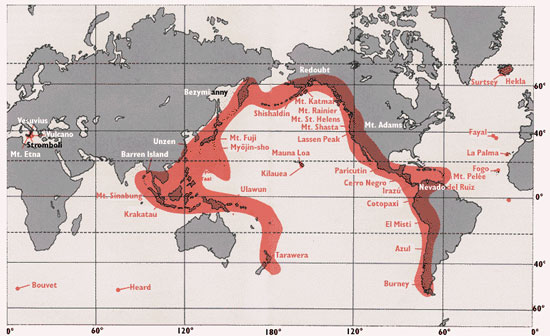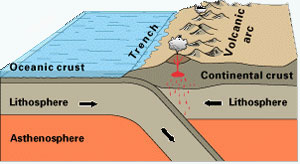

Around 50 people – mostly tourists – were on White Island when the volcano erupted on Monday afternoon, December 9, 2019. Many remain unaccounted for at this writing. The eruption began at around 2:11 p.m., local time. Image via NewsHubNewZealand.
The volcano that erupted today (December 9, 2019) on White Island – which sits about 30 miles (50 km) offshore from mainland New Zealand – is one of a long chain of volcanos in what’s called the Ring of Fire. These volcanoes and other tectonically active structures surround the Pacific Ocean. The chain runs up along the western coast of South and North America, crosses over the Aleutian Islands in Alaska, runs down the eastern coast of Asia past New Zealand and into the northern coast of Antarctica. The Ring of Fire is one of the most geologically active areas on Earth, and is a site for frequent earthquakes and powerful volcanic eruptions.
Read more: 5 dead, many more missing in eruption of New Zealand volcano
Information about the volcano and its tragic aftermath is still coming out, but the tweet below – from volcanologist Jess Phoenix – has more about it.
Here's a little bit of info about the #WhiteIsland #volcano eruption. Please look to @geonet & @USGSVolcanoes for accurate information. The imagery on social media can be scary, but this is a relatively small (yet deadly) eruption. At least 5 people are now reported to have died. pic.twitter.com/uB7ORsMozK
— Jess Phoenix ? (@jessphoenix2018) December 9, 2019
For official information about the White Island eruption in New Zealand, follow @geonet & @gnsscience. Latest update here: https://t.co/4LlOOMpQpa https://t.co/0g53y12xzb
— USGS Volcanoes? (@USGSVolcanoes) December 9, 2019
The New Zealand volcano is one of more than 450 active and dormant volcanoes located within the Ring of Fire. Many of these volcanoes were created through the tectonic process of subduction whereby dense ocean plates collide with and slide under lighter continental plates.
The material from the ocean floor melts as it enters the Earth’s interior and then rises to the nearby surface as magma.
Other noteworthy volcanoes that dot the Ring of Fire include Mount St. Helens in the USA, Mount Fuji in Japan and Mount Pinatubo in the Philippines. Since 1850, approximately 90% of the 16 most powerful volcanic eruptions on Earth have occurred within the Pacific Ring of Fire.

Many volcanoes on Earth are located around the Pacific Ring of Fire. Image Credit: U.S. Geological Survey.

Image of an oceanic plate being subducted under a continental plate. Image Credit: U.S. Geological Survey.
My god, White Island volcano in New Zealand erupted today for first time since 2001. My family and I had gotten off it 20 minutes before, were waiting at our boat about to leave when we saw it. Boat ride home tending to people our boat rescued was indescribable. #whiteisland pic.twitter.com/QJwWi12Tvt
— Michael Schade (@sch) December 9, 2019
The majority of Earth’s earthquakes occur in the Ring of Fire, too. These earthquakes are caused by the sudden lateral or vertical movement of rock along plate margins. About 81% of the world’s largest earthquakes have occurred along the Ring of Fire. The largest earthquake ever recorded on Earth was a 9.5 magnitude earthquake that struck Chile on May 22, 1960. Other noteworthy earthquakes that have occurred along the Ring of Fire include a 9.2 magnitude earthquake that struck Prince William Sound, Alaska on March 28, 1964, a 9.1 magnitude earthquake that struck off the coast of Sumatra on December 26, 2004 and a 9.0 earthquake that struck near the coast of Honshu, Japan on March 11, 2011.
Deep ocean trenches are another common feature of the Ring of Fire. These trenches form along subduction zones where slabs of the ocean floor slide into the Earth. The deepest part of the ocean on Earth, the Mariana Trench, is located along the Ring of Fire in the western portion of the Pacific Ocean Basin.
Despite the high levels of volcanic and seismic activity, millions of people live among the breathtaking landscapes of the Ring of Fire. Scientists are currently working with government officials to help nations in the region improve their response to natural disasters and build their resiliency.
Video shows multiple people evacuating #WhiteIsland during the volcanic eruption. #NuevaZelanda pic.twitter.com/tpdlUegODC
— EL CÍRCULO ? (@CirculoGloBal_I) December 9, 2019
Bottom line: The White Island volcano in New Zealand on December 9, 2019 took place along the Pacific Ring of Fire. Approximately 90% of the most powerful volcanic eruptions and about 81% of the world’s largest earthquakes have occurred along the Ring of Fire.
Enjoying EarthSky? Sign up for our free daily newsletter today!
from EarthSky https://ift.tt/38nOOWc


Around 50 people – mostly tourists – were on White Island when the volcano erupted on Monday afternoon, December 9, 2019. Many remain unaccounted for at this writing. The eruption began at around 2:11 p.m., local time. Image via NewsHubNewZealand.
The volcano that erupted today (December 9, 2019) on White Island – which sits about 30 miles (50 km) offshore from mainland New Zealand – is one of a long chain of volcanos in what’s called the Ring of Fire. These volcanoes and other tectonically active structures surround the Pacific Ocean. The chain runs up along the western coast of South and North America, crosses over the Aleutian Islands in Alaska, runs down the eastern coast of Asia past New Zealand and into the northern coast of Antarctica. The Ring of Fire is one of the most geologically active areas on Earth, and is a site for frequent earthquakes and powerful volcanic eruptions.
Read more: 5 dead, many more missing in eruption of New Zealand volcano
Information about the volcano and its tragic aftermath is still coming out, but the tweet below – from volcanologist Jess Phoenix – has more about it.
Here's a little bit of info about the #WhiteIsland #volcano eruption. Please look to @geonet & @USGSVolcanoes for accurate information. The imagery on social media can be scary, but this is a relatively small (yet deadly) eruption. At least 5 people are now reported to have died. pic.twitter.com/uB7ORsMozK
— Jess Phoenix ? (@jessphoenix2018) December 9, 2019
For official information about the White Island eruption in New Zealand, follow @geonet & @gnsscience. Latest update here: https://t.co/4LlOOMpQpa https://t.co/0g53y12xzb
— USGS Volcanoes? (@USGSVolcanoes) December 9, 2019
The New Zealand volcano is one of more than 450 active and dormant volcanoes located within the Ring of Fire. Many of these volcanoes were created through the tectonic process of subduction whereby dense ocean plates collide with and slide under lighter continental plates.
The material from the ocean floor melts as it enters the Earth’s interior and then rises to the nearby surface as magma.
Other noteworthy volcanoes that dot the Ring of Fire include Mount St. Helens in the USA, Mount Fuji in Japan and Mount Pinatubo in the Philippines. Since 1850, approximately 90% of the 16 most powerful volcanic eruptions on Earth have occurred within the Pacific Ring of Fire.

Many volcanoes on Earth are located around the Pacific Ring of Fire. Image Credit: U.S. Geological Survey.

Image of an oceanic plate being subducted under a continental plate. Image Credit: U.S. Geological Survey.
My god, White Island volcano in New Zealand erupted today for first time since 2001. My family and I had gotten off it 20 minutes before, were waiting at our boat about to leave when we saw it. Boat ride home tending to people our boat rescued was indescribable. #whiteisland pic.twitter.com/QJwWi12Tvt
— Michael Schade (@sch) December 9, 2019
The majority of Earth’s earthquakes occur in the Ring of Fire, too. These earthquakes are caused by the sudden lateral or vertical movement of rock along plate margins. About 81% of the world’s largest earthquakes have occurred along the Ring of Fire. The largest earthquake ever recorded on Earth was a 9.5 magnitude earthquake that struck Chile on May 22, 1960. Other noteworthy earthquakes that have occurred along the Ring of Fire include a 9.2 magnitude earthquake that struck Prince William Sound, Alaska on March 28, 1964, a 9.1 magnitude earthquake that struck off the coast of Sumatra on December 26, 2004 and a 9.0 earthquake that struck near the coast of Honshu, Japan on March 11, 2011.
Deep ocean trenches are another common feature of the Ring of Fire. These trenches form along subduction zones where slabs of the ocean floor slide into the Earth. The deepest part of the ocean on Earth, the Mariana Trench, is located along the Ring of Fire in the western portion of the Pacific Ocean Basin.
Despite the high levels of volcanic and seismic activity, millions of people live among the breathtaking landscapes of the Ring of Fire. Scientists are currently working with government officials to help nations in the region improve their response to natural disasters and build their resiliency.
Video shows multiple people evacuating #WhiteIsland during the volcanic eruption. #NuevaZelanda pic.twitter.com/tpdlUegODC
— EL CÍRCULO ? (@CirculoGloBal_I) December 9, 2019
Bottom line: The White Island volcano in New Zealand on December 9, 2019 took place along the Pacific Ring of Fire. Approximately 90% of the most powerful volcanic eruptions and about 81% of the world’s largest earthquakes have occurred along the Ring of Fire.
Enjoying EarthSky? Sign up for our free daily newsletter today!
from EarthSky https://ift.tt/38nOOWc

Aucun commentaire:
Enregistrer un commentaire